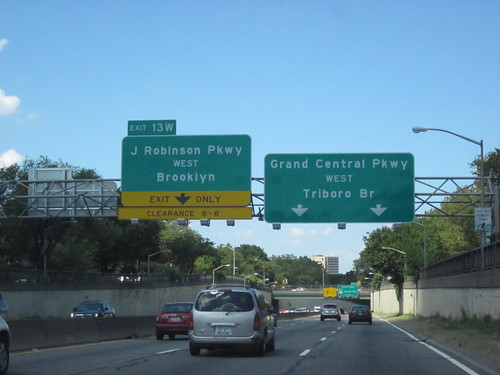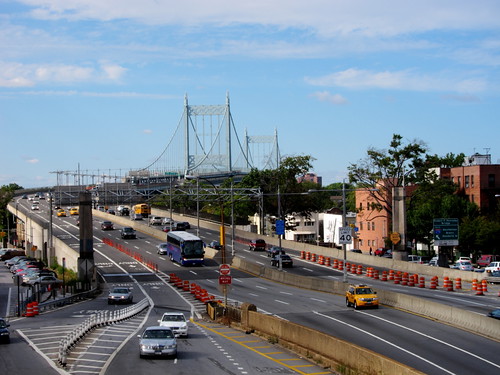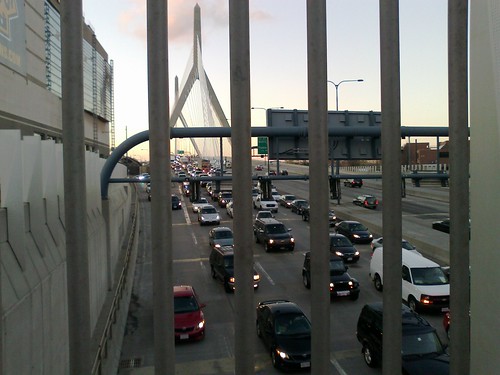Anytime someone makes the excuse that "we need to widen the roads and build more parking lots to accommodate all the cars using it" just remind them that building more infrastructure for cars causes more traffic. This effect was noticed as early as the 1930s. Robert Caro vividly describes the effect of the earliest fully-grade-separated highways on New York:
 |
| Grand Central Parkway on a nice day (source) |
The Grand Central, Interborough, and Laurelton parkways opened early in the summer of 1936 [...] One editorial opined that the new parkways would, by relieving the traffic load on the Southern and Northern State parkways, solve the problem of access to Moses' Long Island parks "for generations."
The new parkways solved the problem for about three weeks. "It wasn't more than three weeks after they opened that I decided to go out to Jones Beach on a Sunday," Paul Windels recalls. "I got on the Interborough and by God it was as jammed as the Southern State ever was." Moses announced that he had the solution: build forty-five miles of new parkways [...]
Some city planners noticed that the traffic pattern on Long Island had fallen into a set pattern: every time a new parkway was built, it quickly became jammed with traffic, but the load on the old parkways was not significantly relieved. If this had been the pattern for the first hundred miles of parkways, they wondered, might it not be the pattern for the next forty-five as well? [p. 515]But when they suggested improved mass transit ideas that groups such as the Regional Plan Association had been proposing, they were ignored.
 |
| The approach to one span of the Triborough (aka RFK) Bridge (source) |
The Triborough Bridge opened on July 11, 1936. [...]
On August 17, 1936, a little more than a month after the Triborough Bridge opened, Long Island's parkways were the scene of what some observers called the greatest traffic tie-up in the history of the metropolitan area.
Referring to it as a "cross-country traffic jam," the Herald Tribune was forced to conclude that the bridge had, at least indirectly, caused it. [...]
Despite the heavy volume on the Triborough Bridge, Othmar Ammann [the chief engineer] said, "the relief of the traffic load on the Queensborough Bridge has not been as great as expected." But the Times editors evidently did not consider this fact particularly noteworthy. [...]
Traffic between Long Island and New York had, before Triborough's opening, flooded the twenty-two lanes available on the four old bridges; suddenly the traffic between Long Island and New York had become so heavy that it was also flooding eight new lanes, the new lanes of the Triborough Bridge---and it was hardly any lighter than before on the old bridges. [p. 518]Again, Moses called for more parkways and what would become the Long Island Expressway. And again, the press went along with it.
The Wantagh State Parkway Extension was opened on December 17, 1938, three months ahead of schedule. [...]
[It] did not receive its first real test of traffic-easing capacity until the first warm weekend morning of 1939. On that morning, it was jammed bumper to bumper for more than three miles. Traffic experts could not understand where those cars had come from. The other Long Island parkways, after all, were just as jammed as ever. [p. 517]Having observed the problems, the RPA attempted to get provisions for a railroad link included on the proposed Bronx-Whitestone bridge. Moses refused to consider it.
 |
| The Bronx-Whitestone Bridge (source) |
During 1940, the first full year of operation, 6,317,489 vehicles passed through the Bronx-Whitestone's toll booths, cramming its four lanes to capacity and causing massive tie-ups on it. Traffic on the Triborough was reduced by 122,519 vehicles. Traffic on the other four East River bridges was reduced not at all. In fact, it rose slightly. Somehow the new bridge had generated, in a single year, more than 6,000,000 new on-and-off-Island motor trips. [...]
Shortly after the bridge opened, Moses completed the road linking the bridge with Westchester County, the Hutchinson River Parkway. Soon, that was jammed too. [p.519]At this point the book turns to the Gowanus Parkway, an elevated highway which ripped through the thriving Brooklyn neighborhood of Sunset Park, and destroyed the heart of it on Third Avenue. It replaced the elevated train line of Third Avenue which was supposed to be taken down in favor of the newly constructed Fourth Avenue subway. Instead it was replaced by a massive concrete elevated highway and the four lane avenue beneath was widened into a 10-lane road to carry the trucks which Moses would not allow on his "parkway."
Below the Gowanus Expressway (formerly Parkway) (source)
The construction of the Gowanus Parkway, laying a concrete slab on top of lively, bustling Third Avenue, buried the avenue in shadow, and when the parkway was completed, the avenue was cast forever in darkness and gloom, and its bustle and life were forever gone. [...] Stores, restaurants and theaters had brought people to Third Avenue. Now half the stores, restaurants and theaters were gone.
The El had brought people through Third Avenue on their way to and from its stations. The parkway did not. Moreover, although the El had been a huge, gloomy structure, it was, as Cathy Wylde puts it, "one that people from the neighborhood relate to; they traveled on it, they were familiar with it." [...] "The highway was something different," Miss Wylde says. "It was noise, dirt, accidents, not lighted, a garbage dump, drag races along it in the night, wild kids, something totally negative. It was a tremendous psychological barrier. In a way you could say the people feared the highway." [...] Once the avenue had been a place for people; Robert Moses had made it into a place for cars. And as the avenue's roadway became more crowded, its sidewalks began to empty. [p. 523]
No sooner would Moses open the Brooklyn-Battery Tunnel at one end of the Gowanus Parkway and the Belt Parkway at the other than the Gowanus would be jammed solid with traffic. At rush hours, the traffic trying to get up onto it would be backed up solid, spilling off the ramps and back into the neighborhood for blocks. [p. 525]
Merging into the Henry Hudson Parkway from the George Washington Bridge (source)
But quite possibly the largest project of this time period was the so-called West Side Improvement: the Henry Hudson bridge at the northernmost tip of Manhattan and the parkway connecting to the West Side Elevated Highway at 72nd Street. Moses claimed it only cost $24 million at the time, a figure wildly out of line with reality. Robert Caro estimates that the true cost was between $180 and $218 million in 1937, which would probably fall somewhere between $3,000 and $4,000 million in 2012 dollars. Besides the highway he did create a linear park, although much of it was blocked from the riverside by the highway. And the park suddenly vanishes when it reaches the part of Manhattan with the highest minority population at the time (Moses' racism is a whole topic unto itself). But we are on the topic of induced demand, so what happened with the West Side Improvement? No surprise to us:
Motorists pulling up to pay their tolls found themselves at the end of lines that seemed little, if any, shorter than the lines had been at the old Broadway bridge, whose congestion New York had considered intolerable. And there was another puzzling fact. Although the new bridge had been built to relieve the congestion on the old bridge, congestion on the old bridge had not been noticeably relieved. The lines of cars waiting to cross it were, in fact, almost as long as ever. [...]
The rush-hour jams were just as bad as the rush-hour jams had been on Riverside Drive before the West Side Improvement was built; reporters escorted over the West Side Improvement before it opened had found it reduced the time required for the nine-mile trip from sixty-eight minutes to twenty-six; now one of those reporters made the trip over the West Side Improvement at two rush hours---admittedly very bad ones---and found that on one trip it took fifty-eight minutes, on the other seventy-three. And looking at the situation that way, the total effect on traffic congestion of the West Side Improvement had been to move the congestion one block west---and yet there was still congestion on Riverside Drive, congestion that had been eased only slightly by the construction of a parallel route. [p. 563]
 |
| The Zakim Bridge leading into the Central Artery/Tunnel |
Did we learn our lesson from this exercise in wasteful spending for little benefit and heavy cost to quality of life? Of course not. The Big Dig cost $15 billion before interest, and this is what the Boston Globe had to say about induced demand when they did some investigation:
Ultimately, many motorists going to and from the suburbs at peak rush hours are spending more time stuck in traffic, not less. The phenomenon is a result of a surge in drivers crowding onto highways - an ironic byproduct of the Big Dig's success in clearing away downtown traffic jams.
 |
| The Greenway boulevard atop the Central Artery/Tunnel |
But hey, at least downtown's not covered by the Green Monster anymore, right? That's got to be worth something. Not $15 billion though. And not for a highway which should not have been built in the first place. The correct answer would have been to take it down and---at a fraction of the cost---replace it with a more appropriate boulevard having its congestion managed through pricing. Well, now the money's been spent, and in fact, we got the worst of both options: the above-ground boulevard stinks up the Greenway and the tunnel funnels cars into new chokepoints around the city. Oops.
Back in New York State, Governor Cuomo is attempting to force through a new Tappan Zee bridge that---like the Bronx-Whitestone---lacks bus lanes or railroad provisions. He even compared himself to Robert Moses at one point. The opposition is stronger this time, but it's an open question who will prevail.
 |
| Part of the Bowker Overpass |
Much of the 1950s automobile infrastructure in Metro Boston is decaying and coming to end-of-life. It could easily cost hundreds of millions, or even billions, of dollars to repair deteriorating tunnels and bridges. With the issue of transportation funding in the air, the fact shouldn't be lost that it is not worthwhile to restore these facilities to their 1950 state. We should not be held hostage to "traffic projections" when history so clearly shows that traffic is induced by the existence of these facilities in the first place. The roads have to be fixed in some way, as in many cases they are beyond repair. We could save a whole lot of money by choosing more appropriate, scaled-down designs which integrate with the city and improve quality of life for residents as well as visitors.
As for The Power Broker, there's tons more great material to sort through, I had to pare down quite a lot of excellent prose to keep the length of this post from becoming overwhelming. So I recommend checking it out yourself. Most of the quotes are from the first chapters of Part V, The Love of Power.
No comments:
Post a Comment
Note: Only a member of this blog may post a comment.